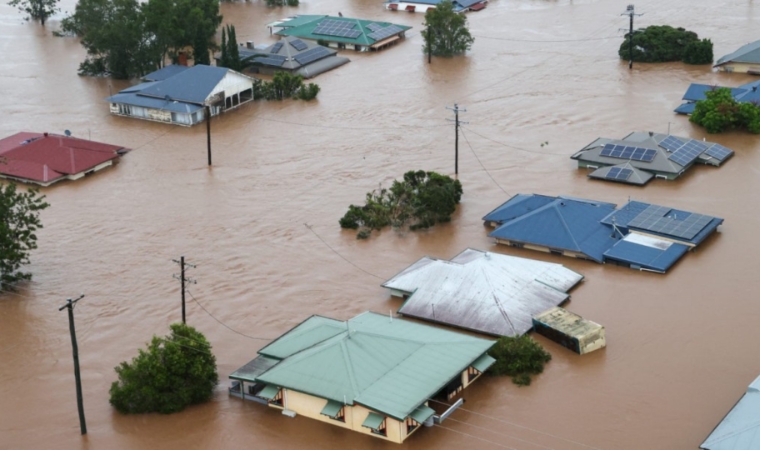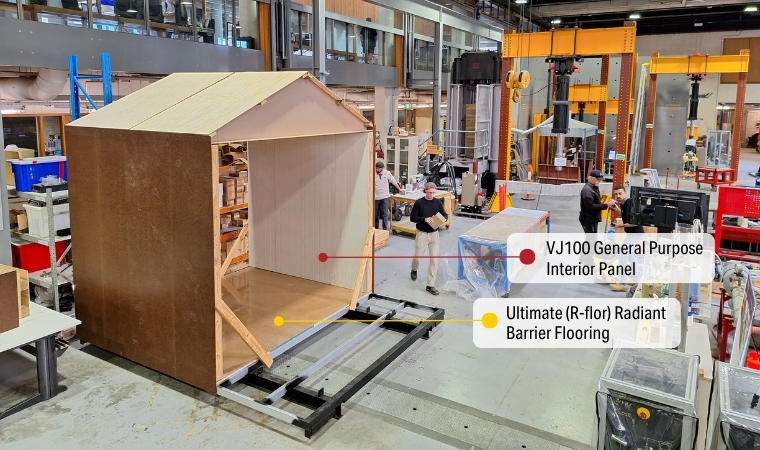A New Era of Sustainable Housing
This project seeks to redefine how temporary housing is conceptualized and constructed. It revolves around the creation of timber-cardboard sandwich panels—a revolutionary structural composite made primarily of recovered waste cardboard and under-utilised timber. These materials, readily available in Northern New South Wales, are transformed into components that outperform conventional foam-core insulated panels by 30% in structural efficiency. Beyond their technical benefits, these panels exemplify a commitment to sustainability, promoting the use of renewable and recycled materials in temporary housing construction. The project also supports the development of new and expanded regional manufacturing capabilities, fostering growth in bio-based modular housing systems.
Addressing Disaster Recovery Challenges
The 2022 floods in Lismore, on the NSW North Coast, served as a stark reminder of the devastating impact natural disasters can have on communities. Thousands of residents were displaced, many of who waited months for suitable shelter due to the lack of high-quality, rapid-deployment housing solutions. The increasing frequency and intensity of such disasters, driven by climate change, has heightened the urgency for adaptable, durable, and sustainable temporary housing solutions.

This initiative directly addresses this challenge by creating a model that prioritises speed, comfort, and resilience. By using locally sourced materials, the project reduces reliance on complex logistics and transportation, enabling quicker assembly and lower costs. This not only accelerates the recovery process for disaster-stricken communities but also supports regional economies. Moreover, the system’s innovative design demonstrates how materials often considered waste can be transformed into high-performing building components that meet modern housing standards.
Materials from Australian Panels
Integral to this groundbreaking project are two standout products from Australian Panels: STRUCTAflor Ultimate (R-Flor) and easycraft VJ100.
STRUCTAflor Ultimate, equipped with cutting-edge radiant barrier technology, was specifically chosen for its moisture vapor retarding effect, thanks to the perforated aluminium foil layer. This feature is crucial as it provides protection to the particleboard flooring and floor coverings by reducing the ability of moisture from the subfloor area to enter the structure, making it ideal for installation in damp areas. Other key benefits of STRUCTAflor Ultimate include:
- Reducing the potential for mould growth on the underside of the flooring.
- Enhancing the overall System R values (thermal insulation).
- BAL 29 fire rating compliance, adding a layer of fire protection.
Meanwhile, easycraft VJ100 combines aesthetic finesse with unmatched durability, contributing to the visual and structural integrity of the temporary housing units.

Prototyping a Solution
The culmination of this initiative is a full-scale prototype—a tangible embodiment of the project’s goals. Weatherproof, safe, and remarkably comfortable, this temporary home redefines how recycled materials can serve humanity. During a public showcase at Southern Cross University in Lismore, visitors of all ages explored the house, touching its features, asking questions about the technologies used, and sharing overwhelmingly positive feedback. Minister Jihad Dib, NSW Minister for Emergency Services, visited the site along with Benjamin Roche, Pro Vice-Chancellor (Research and Education Impact) at SCU, and Andrew Hurford, owner of Hurford Wholesale and a key project partner. Their presence underscored the importance of this innovation in disaster response.
Next Steps
The prototype has since been been relocated back to Brisbane for an intensive durability assessment throughout the summer season. Exposed to sub-tropical storms, high humidity, and heavy rainfall, the structure is undergoing real-world testing to evaluate its resilience under extreme weather conditions. By continuing this rigorous testing and gathering stakeholder input, the project takes another significant step toward delivering a groundbreaking solution for sustainable, resilient temporary housing.
Industry and Funding Collaboration
This project is more than a technical achievement; it is a triumph of collaboration. It brings together expertise from government, research, and industry partners, representing every stage of the value chain—from forest resources to wood products and final building applications.
Funded by the NSW Decarbonisation Innovation Hub and Land and Primary Industries Network, this seed initiative is a testament to how cross-sector partnerships can foster radically new approaches to resource-efficient building design. The result is a low-carbon, sustainable, and scalable delivery model perfectly suited for post-disaster temporary housing.
Looking Ahead
This collaboration sets a new benchmark in sustainable construction, turning waste into opportunity and challenges into triumphs. By significantly increasing the capacity to use renewable and recycled materials, the project not only addresses immediate housing needs but also paves the way for expanded regional manufacturing in bio-based modular housing systems.
Australian Panels is deeply honoured to contribute to this groundbreaking effort, showcasing the transformative power of partnership, innovation, and environmental stewardship. To delve deeper into this remarkable initiative, watch the SCU Project Video or explore the project in more details here.
